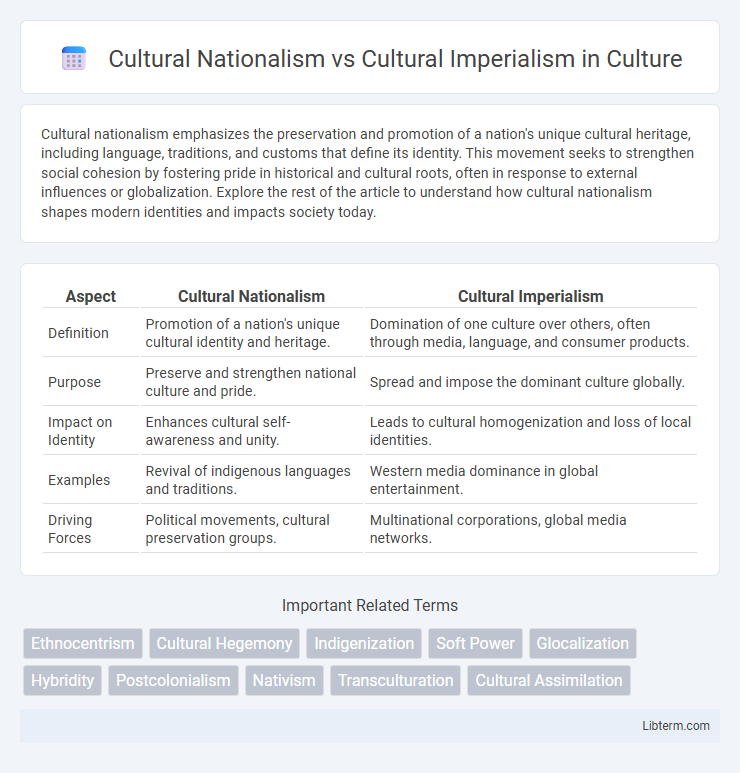Cultural nationalism emphasizes the preservation and promotion of a nation's unique cultural heritage, including language, traditions, and customs that define its identity. This movement seeks to strengthen social cohesion by fostering pride in historical and cultural roots, often in response to external influences or globalization. Explore the rest of the article to understand how cultural nationalism shapes modern identities and impacts society today.
Table of Comparison
| Aspect | Cultural Nationalism | Cultural Imperialism |
|---|---|---|
| Definition | Promotion of a nation's unique cultural identity and heritage. | Domination of one culture over others, often through media, language, and consumer products. |
| Purpose | Preserve and strengthen national culture and pride. | Spread and impose the dominant culture globally. |
| Impact on Identity | Enhances cultural self-awareness and unity. | Leads to cultural homogenization and loss of local identities. |
| Examples | Revival of indigenous languages and traditions. | Western media dominance in global entertainment. |
| Driving Forces | Political movements, cultural preservation groups. | Multinational corporations, global media networks. |
Defining Cultural Nationalism
Cultural nationalism emphasizes the promotion and preservation of a nation's unique cultural identity, traditions, language, and values as a means of fostering unity and resisting external cultural influences. It often arises in response to cultural imperialism, where dominant cultures impose their practices and ideologies, potentially eroding local customs. Key examples include the Irish Gaelic revival and the Quebec sovereignty movement, both emphasizing cultural distinctiveness to maintain national heritage.
Understanding Cultural Imperialism
Cultural imperialism involves the dominance of one culture over others, often through media, language, and consumer products, leading to the erosion of indigenous cultures and identities. This phenomenon is driven by powerful nations exporting their values and cultural norms, impacting global cultural diversity. Understanding cultural imperialism requires analyzing its effects on local traditions, social structures, and the resistance movements that seek to preserve cultural autonomy.
Historical Roots of Cultural Nationalism
Cultural nationalism emerged in the 19th century as a response to imperial domination and cultural erosion, emphasizing the preservation and revival of indigenous languages, traditions, and identities. Rooted in the Romantic movement, it sought to assert national distinctiveness against the homogenizing forces of empire, particularly in Europe and colonized regions. Key historical examples include the Gaelic Revival in Ireland and the Bengali Renaissance in India, which fostered cultural pride and resistance to British colonial cultural imperialism.
Origins and Evolution of Cultural Imperialism
Cultural imperialism originated during the age of European colonial expansion, where dominant powers imposed their cultural values, language, and institutions on colonized societies to maintain control and exploit resources. Over time, it evolved through globalization and media dominance, with Western cultural products and ideologies spreading worldwide, often at the expense of local traditions and identities. This dynamic challenges cultural nationalism, which seeks to preserve and promote indigenous heritage in response to perceived cultural homogenization.
Key Differences Between Nationalism and Imperialism
Cultural nationalism emphasizes the preservation and promotion of a nation's unique cultural identity, language, and traditions as a form of resistance against external influences. In contrast, cultural imperialism involves the domination and imposition of one culture over others, often through media, education, and economic power, leading to cultural homogenization. The key difference lies in nationalism's focus on protecting and strengthening indigenous culture, while imperialism seeks to extend and impose the dominant culture beyond its original borders.
Impact on Identity and Society
Cultural nationalism strengthens collective identity by promoting indigenous traditions, languages, and values, fostering social cohesion and resistance to cultural homogenization. Cultural imperialism, driven by dominant nations' cultural exports, often erodes local identities, causing cultural displacement and loss of heritage. The tension between these forces shapes societal dynamics, influencing policy, social integration, and cultural preservation efforts worldwide.
Globalization and Cultural Exchange
Globalization intensifies the tension between cultural nationalism and cultural imperialism as it facilitates widespread cultural exchange while threatening local identities. Cultural nationalism seeks to preserve indigenous traditions and languages against the homogenizing effects of dominant global cultures often propagated through media, trade, and technology. In contrast, cultural imperialism promotes the dominance of powerful nations' cultural norms, leading to the erosion of diverse cultural expressions and reinforcing global inequalities in cultural representation.
Case Studies: Real-World Examples
Cultural nationalism is exemplified by the Quebec sovereignty movement in Canada, where efforts to preserve French language and heritage resist Anglophone cultural dominance. In contrast, cultural imperialism is evident in the spread of American fast food chains like McDonald's in India, which challenges traditional Indian culinary practices and promotes Western consumer culture. These case studies highlight how cultural nationalism seeks to protect indigenous identities, while cultural imperialism often leads to the homogenization of diverse cultures.
Challenges and Criticisms of Both Concepts
Cultural nationalism faces challenges in promoting a homogeneous cultural identity, which often marginalizes minority groups and restricts cultural diversity. Cultural imperialism is criticized for undermining local traditions by imposing dominant cultural values, leading to cultural homogenization and loss of indigenous heritage. Both concepts struggle with balancing cultural preservation and openness, creating tensions between global integration and protection of unique cultural identities.
Toward a Balanced Cultural Future
Cultural nationalism emphasizes preserving indigenous traditions, languages, and identities as a means to resist cultural domination and promote self-determination. Cultural imperialism, on the other hand, involves the spread of dominant cultural values and practices that often overshadow or marginalize local cultures. Toward a balanced cultural future requires fostering mutual respect, encouraging cultural exchange without assimilation, and supporting policies that protect cultural diversity while embracing global interconnectedness.
Cultural Nationalism Infographic

 libterm.com
libterm.com